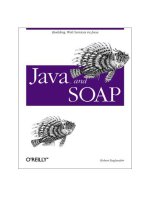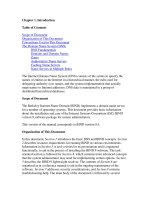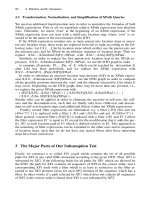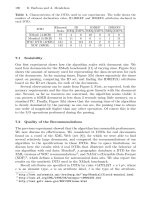Tài liệu Database Fundamentals by Robert J. Robbins docx
Bạn đang xem bản rút gọn của tài liệu. Xem và tải ngay bản đầy đủ của tài liệu tại đây (214.38 KB, 31 trang )
Database Fundamentals: 1File: N_drive:\jhu\class\1995\db-fund.ppt © 1994, 1995 Robert Robbins
Database
Fundamentals
Robert J. Robbins
Johns Hopkins University
Database Fundamentals: 2File: N_drive:\jhu\class\1995\db-fund.ppt © 1994, 1995 Robert Robbins
What is a Database?
General:
• A database is any collection of related data.
Restrictive:
• A database is a persistent, logically coherent
collection of inherently meaningful data, relevant
to some aspects of the real world.
The portion of the real world relevant to the database is sometimes referred
to as the universe of discourse or as the database miniworld. Whatever it
is called, it must be well understood by the designers of the database.
Database Fundamentals: 3File: N_drive:\jhu\class\1995\db-fund.ppt © 1994, 1995 Robert Robbins
What is a Database Management System?
A database management system (DBMS) is a
collection of programs that enables users to create
and maintain a database. According to the
ANSI/SPARC DBMS Report (1977), a DBMS
should be envisioned as a multi-layered system:
Conceptual
Schema
Physical
Database
Internal
Schema
External
View 1
• • • • •• • • • •
External
View n
External Level
(individual user views)
Conceptual Level
(Enterprise-wide view\)
Internal Level
(storage view)
Storage Level
(physical storage)
Database Fundamentals: 4File: N_drive:\jhu\class\1995\db-fund.ppt © 1994, 1995 Robert Robbins
What Does a DBMS Do?
Database management systems provide several
functions in addition to simple file management:
• allow concurrency
• control security
• maintain data integrity
• provide for backup and recovery
• control redundancy
• allow data independence
• provide non-procedural query language
• perform automatic query optimization
Database Fundamentals: 5File: N_drive:\jhu\class\1995\db-fund.ppt © 1994, 1995 Robert Robbins
Who Interacts with a DBMS?
Many different individuals are involved with a
database management system over its life:
• systems analysts
• database designers
• database administrators
• application developers
• users
Database Fundamentals: 6File: N_drive:\jhu\class\1995\db-fund.ppt © 1994, 1995 Robert Robbins
Components of a Database System
DML
Processor
Application
Programs
Direct User
Queries
Database
Description
Tables
DDL
Compiler
Database
Administrator
Concurrent
Access
Tables
Authorization
Tables
File
Manager
Database
Manager
Physical
System
Database
Metadata
Database
System
Catalog
Database Fundamentals: 7File: N_drive:\jhu\class\1995\db-fund.ppt © 1994, 1995 Robert Robbins
Relational Database Model
What is a relational database?
• a database that treats all of its data as a
collection of relations
What is a relation?
• a kind of set
• a subset of a Cartesian product
• an unordered set of ordered tuples
Database Fundamentals: 8File: N_drive:\jhu\class\1995\db-fund.ppt © 1994, 1995 Robert Robbins
Basic Set Concepts
any collection of distinct entities of any
sort.
SET
a set of ordered pairs, produced by
combining each element of one set with
each element of another set.
CARTESIAN
PRODUCT
a subset of a Cartesian productRELATION
examples A = { 1,2,3,4,5,6 }
B = { H,T }
C = { R,B }
D = { Grant, Sherman, Lee }
example B x C = { <H,R>,<H,B>,<T,R>,<T,B> }
example Q = { <H,R>,<H,B> }
Note: Cartesian products may be generated by
multiplying any number of sets together.
The actual number of sets involved in a
particular case is said to be the “
degree
”
or “
arity
” of that Cartesian product.
Note: Relations may be of any degree (arity).
Database Fundamentals: 9File: N_drive:\jhu\class\1995\db-fund.ppt © 1994, 1995 Robert Robbins
Basic Set Concepts
A set is usually indicated by including a comma-
delimited list of the names its members within a
pair of wavy brackets:
R = { 1,2,3,4,5,6 }
G = { Marshall, Eisenhower, Bradley }
The members of a set are
unordered
. Two sets
are considered equivalent if and only if they
contain exactly the same members, without regard
for the order in which the members are listed.
R = { 1,2,3,4,5,6 }
= { 3,2,1,6,4,5 }
G = { Marshall, Eisenhower, Bradley }
= { Bradley, Marshall, Eisenhower }
Database Fundamentals: 10File: N_drive:\jhu\class\1995\db-fund.ppt © 1994, 1995 Robert Robbins
Basic Set Concepts
Order must be maintained in ordered n-tuples.
Two tuples are considered different if they contain
the same members in a different order.
S = < 2,4 > ≠≠ < 4,2 >
C = < Marshall, Eisenhower, Bradley >
≠≠ < Bradley, Eisenhower, Marshall >
An
ordered
double (or triple or quadruple or n-
tuple) is usually indicated by including a comma-
delimited list of the names its members within a
pair of pointed brackets:
S = < 2,4 >
C = < Marshall, Eisenhower, Bradley >
A set may consist of an unordered collection of
ordered tuples. For example, we could imagine
the set of all ordered pairs of integers, such that
the first element is the square root of the second
element.
R = { <1,1>,< 2,4 >,<3,9> }
As this ellipsis indicates, sets can be
infinite in size. However, sets that
are actually represented in a database
must be finite.
Database Fundamentals: 11File: N_drive:\jhu\class\1995\db-fund.ppt © 1994, 1995 Robert Robbins
Basic Set Concepts
LET B be the set of possible outcomes when rolling
a single blue die.
B = { 1,2,3,4,5,6 }
LET
R be the set of possible outcomes when rolling
a single red die.
R = { 1,2,3,4,5,6 }
The Cartesian product R x B gives the set of
outcomes when the two dice are rolled
together:
THEN
R x B:
<1,1>
<1,2>
<1,3>
<1,4>
<1,5>
<1,6>
<2,1>
<2,2>
<2,3>
<2,4>
<2,5>
<2,6>
<3,1>
<3,2>
<3,3>
<3,4>
<3,5>
<3,6>
<4,1>
<4,2>
<4,3>
<4,4>
<4,5>
<4,6>
<5,1>
<5,2>
<5,3>
<5,4>
<5,5>
<5,6>
<6,1>
<6,2>
<6,3>
<6,4>
<6,5>
<6,6>
{
}
Database Fundamentals: 12File: N_drive:\jhu\class\1995\db-fund.ppt © 1994, 1995 Robert Robbins
Relation:
Subset of a Cartesian Product
1
2
3
4
5
6
Set R
1
2
3
4
5
6
Set B
Starting two sets.
A Cartesian product of two sets
can be generated by combining
every member of one set with
every member of the other set.
This results in a complete set of
ordered pairs, consisting of
every possible combination of
one member of the first set
combined with one member of
the second set. The number of
elements in a Cartesian product
is equal to M x N, where M and
N give the number of members
in each set.
A Cartesian product of two sets,
shown as a list of ordered pairs.
<1,1>
<1,2>
<1,3>
<1,4>
<1,5>
<1,6>
<2,1>
<2,2>
<2,3>
<2,4>
<2,5>
<2,6>
<3,1>
<3,2>
<3,3>
<3,4>
<3,5>
<3,6>
<4,1>
<4,2>
<4,3>
<4,4>
<4,5>
<4,6>
<5,1>
<5,2>
<5,3>
<5,4>
<5,5>
<5,6>
<6,1>
<6,2>
<6,3>
<6,4>
<6,5>
<6,6>
1
2
3
4
5
6
1
2
3
4
5
6
A Cartesian product of two sets,
shown as a connection diagram,
with each member of the first set
connected to each member of the
other set.
Database Fundamentals: 13File: N_drive:\jhu\class\1995\db-fund.ppt © 1994, 1995 Robert Robbins
Relation:
Subset of a Cartesian Product
<1,1>
<1,2>
<1,3>
<1,4>
<1,5>
<1,6>
<2,1>
<2,2>
<2,3>
<2,4>
<2,5>
<2,6>
<3,1>
<3,2>
<3,3>
<3,4>
<3,5>
<3,6>
<4,1>
<4,2>
<4,3>
<4,4>
<4,5>
<4,6>
<5,1>
<5,2>
<5,3>
<5,4>
<5,5>
<5,6>
<6,1>
<6,2>
<6,3>
<6,4>
<6,5>
<6,6>
<1,1>
<2,2>
<3,3>
<4,4>
<5,5>
<6,6>
A relation, therefore, must always
be representable as a subset of some
Cartesian product.
A Cartesian product pairs every
member of the first set with every
member of the second set.
A relation pairs some
members of the first set
with some members of
the second set.
Database Fundamentals: 14File: N_drive:\jhu\class\1995\db-fund.ppt © 1994, 1995 Robert Robbins
Relation:
Set of Ordered Tuples
By adding sets, relations can be extended to include ordered triples, ordered
quadruples or, in general, any ordered n-tuple, as below. A relation with n
participating sets is said to be of degree n or to possess arity n.
A binary relation is a set of ordered doubles, with one element a member of the
first set and one element a member of the second set. Generally, we could
represent a set of ordered doubles as below. S
1
is the first set and S
2
the second.
S
1
x S
2
•
•
•
•
•
•
•
•
•
•
•
•
•
•
•
•
•
•
•
•
•
•
•
•
•
•
•
S
1
x S
2
x S
3
x x S
n
• • • • • • • • •
• • • • • • • • •
• • • • • • • • •
• • • • • • • • •
• • • • • • • • •
• • • • • • • • •
• • • • • • • • •
Database Fundamentals: 15File: N_drive:\jhu\class\1995\db-fund.ppt © 1994, 1995 Robert Robbins
Relations as a Database
Codd recognized that many of the files used in computerized information
systems were very similar in structured to tabularized relations.
•
•
•
•
•
•
•
•
•
•
•
•
•
•
•
•
•
•
S
1
x S
2
x S
3
x x S
n
• • • • • • • • •
• • • • • • • • •
• • • • • • • • •
• • • • • • • • •
• • • • • • • • •
• • • • • • • • •
• • • • • • • • •
An n-ary relation (i.e., a subset of a Cartesian product of n sets) could be be
represented in a computer system as an n-column tabular file, with one member
from the first set named in the first column of each record and one member of
the second set in the second column, etc.
Smith
Smith
Jones
Harris
Robert
Judy
Greg
Lloyd
1154 Elm Street
1154 Elm Street
765 Cedar Lane
2323 Maple Dr
Glendale
Glendale
Towson
Towson
MD
MD
MD
MD
21200
21200
21232
21232
L.
F.
G.
K.
Ziegler Fred 7272 Cherry Ln. Baltimore MD 21208K.
•
•
•
•
•
•
•
•
•
•
•
•
•
•
•
•
•
•
•
•
•
•
•
•
Database Fundamentals: 16File: N_drive:\jhu\class\1995\db-fund.ppt © 1994, 1995 Robert Robbins
Relations as a Database
The business data file resembles a relation in a number of ways. The tabular
file itself corresponds to a relation. Each column, or attribute, in the file
corresponds to a particular set and all of the values from a particular column
come from the same domain, or set. Each row, or record, in the file
corresponds to a tuple
Smith
Smith
Jones
Harris
Robert
Judy
Greg
Lloyd
1154 Elm Street
1154 Elm Street
765 Cedar Lane
2323 Maple Dr
Glendale
Glendale
Towson
Towson
MD
MD
MD
MD
21200
21200
21232
21232
L.
F.
G.
K.
Ziegler Fred 7272 Cherry Ln. Baltimore MD 21208K.
•
•
•
•
•
•
•
•
•
•
•
•
•
•
•
•
•
•
•
•
•
•
•
•
Name-L Name-F MI address city state zip
Domains
(sets)
If such a file is to be genuinely interchangeable with a relation, certain
contraints must be met:
• every tuple must be unique
• every attribute within a tuple must be single-valued
• in in all tuples, the values for the same attribute must come from the
same domain or set
• no attributes should be null
Database Fundamentals: 17File: N_drive:\jhu\class\1995\db-fund.ppt © 1994, 1995 Robert Robbins
Relations as a Database
•
•
•
•
•
•
•
•
•
•
•
•
•
•
•
•
•
•
P-64122
P-75642
P-70875
P-79543
P-71536
123-45-6789
001-32-6873
444-44-5555
555-12-1212
888-88-8888
Smith
Pedersen
Wilson
Grant
MacPherson
123 Main Street
1700 Cedar Barn Way
1321 North South St
808 Farragut Avenue
1617 Pennsylvania Ave
10 MAY 44
31 MAR 59
7 AUG 90
1 DEC 66
11 APR 60
patient # SS # Last Name address birth date
An essential attribute of a relation is that every tuple must be unique. This
means that the values present in some individual attribute (or set of attributes)
must always provide enough information to allow a unique identification of
every tuple in the relation. In a relational database, these identifying values
are known as key values or just as the key.
Sometimes more than one key could be defined for given table. For
example, in the table below (which represents, perhaps, a patient record file),
several columns might serve as a key. Either patient number (assigned by
the hospital) or social security number (brought with the patient) are
possibilities. In addition, one might argue that the combination of last name,
address, and birth date could collectively serve as a key.
Any attribute or set of attributes that might possibly serve as a key is known
as a candidate key. Keys that involve only one attribute are known as
simple keys. Keys that involve more than one attribute are composite keys.
In designing a database, one of the candidate keys for each relation must be
chosen to be the primary key for that table. Choosing primary keys is a
crucial task in database design. If keys need to be redesignated, the entire
system may have to be redone. Primary keys can never be null and should
never be changed. Sometimes none of the candidate keys for a relation are
likely to remain stable over time. Then, an arbitrary identifier might be created
to serve as a primary key. Such arbitrary keys are also known as surrogate
keys.
Database Fundamentals: 18File: N_drive:\jhu\class\1995\db-fund.ppt © 1994, 1995 Robert Robbins
Relations as a Database
A binary relation (i.e., a subset of a Cartesian product of two sets) could be be
represented in a computer system as two-column tabular file, with one member
from the first set named in the first column of each record and one member of
the second set in the second column. For example, a binary relation could be
used to provide unique three-letter identifiers for academic departments.
Additional relations could be used to give more information about individual
departments or individual faculty members.
ZOL
CPS
BSP
CEM
PSD
Zoology
Computer Science
Biological Science
Chemistry
Political Science
Room 203
Room 714A
Room 141
Room 320
Room 303
Natural Science Bldg
Wells Hall
Natural Science Bldg
Chemistry Bldg
South Kedzie Hall
355 4640
355 5210
353 4610
355 9175
355 6590
•
•
•
•
•
•
•
•
•
•
•
•
•
•
•
•
•
•
•
•
•
•
•
•
•
•
•
•
•
•
•
•
•
•
•
•
•
•
•
•
•
•
999-99-9999
888-88-8888
777-77-7777
666-66-6666
Johnson
Johnson
Brown
Brown
William
William
James
Gwen
1533 Raleigh Dr.
2842 Colony Ave.
99 W. East St.
99 W. East St.
Baltimore
Baltimore
Towson
Towson
MD
MD
MD
MD
21211
21201
21232
21232
F.
F.
G.
K.
111-11-1111
Ziegler Samual 7272 Cherry Ln. Baltimore MD 21208L.
•
•
•
•
•
•
Zoology
Political Science
Computer Science
History
Accounting
ZOL
PSD
CPS
HIS
ACC
•
•
•
•
•
•
Database Fundamentals: 19File: N_drive:\jhu\class\1995\db-fund.ppt © 1994, 1995 Robert Robbins
Yet another relation could be used to show what faculty were members of what
departments. Notice that faculty member 999-99-9999 is a member of more
than one department and that, even on this short list, the department of zoology
has two members given.
SS Number • • • other fields
Faculty Relation
Dept CodeSS Number
Member-of Relation
Dept Code other fields • • •
Departments Relation
Relations of this sort, that combine identifiers from two other relations, provide
the “glue” that holds a relational database together.
Relations as a Database
Whenever the values in an attribute column in one table “point to” primary keys
in another (or the same) table, the attribute column is said to be a
foreign key
.
Columns containing foreign keys are subject to an
integrity constraint
: any
value present as a foreign key must also be present as a primary key.
999-99-9999
888-88-8888
7777-77-7777
666-66-6666
999-99-9999
ZOL
PSD
CPS
ZOL
BSP
•
•
•
•
•
•
•
•
•
Database Fundamentals: 20File: N_drive:\jhu\class\1995\db-fund.ppt © 1994, 1995 Robert Robbins
Relational Database Operators
Data models consist of data structures and
permitted operations on those data structures.
Part of Codd’s genius was to recognize that
many of the standard set operators that can take
relations as operands map nicely to real data
manipulation problems:
• Cartesian product
•union
• intersection
• difference
Codd devised some additional operators to
provide extra manipulatory power:
• select
• project
• join
• divide
The operators have now been extended to
include more useful manipulations:
• outer join
• outer union
Database Fundamentals: 21File: N_drive:\jhu\class\1995\db-fund.ppt © 1994, 1995 Robert Robbins
Relational Database Normal Forms
First Normal Form:
• A relation is in first normal form (1NF)
if and only if all underlying domains
contain atomic values only.
Second Normal Form:
• A relation is in second normal form
(2NF) if and only if it is in 1NF and
every non-key attribute is fully
dependent on the primary key.
Third Normal Form:
• A relation is in third normal form (3NF)
if and only if it is in 2 NF and the non-
key attributes are mutually
independent.
Considerable study has been made of the properties of relations as they affect
the behavior of relational databases. The results of these studies are captured in
the definition of normal forms.
Database Fundamentals: 22File: N_drive:\jhu\class\1995\db-fund.ppt © 1994, 1995 Robert Robbins
What is the E-R Data Model?
The Entity-Relationship (E-R) data model is a
semantically rich model that can be mapped to a
relational system.
The three files represented above are all relations in the formal sense. Chen
(1976) noted that different relations may play different roles in a database and
that being able to recognize and document those roles is a key part of database
design. The “faculty” and the “department” relations above both store
information about particular real-world entities. The “member-of” relation, on
the other hand, stores information about specific relationships involving
individual pairs of real-world entities.
SS Number • • • other fields Faculty Relation
Dept CodeSS Number
Member-of Relation
Dept Code other fields • • •
Departments Relation
Database Fundamentals: 23File: N_drive:\jhu\class\1995\db-fund.ppt © 1994, 1995 Robert Robbins
The E-R Data Model
Physical
Database
Conceptual
Database
External
View 1
• • • • •• • • • •
External
View n
Physical data independence
occurs here.
Logical data independence
occurs here.
Implemented on physical
devices, using a commercial
database product
Definition and mapping
written in data definition
language
Different needs for access and use of the
database can be supported through different
user views
Database Fundamentals: 24File: N_drive:\jhu\class\1995\db-fund.ppt © 1994, 1995 Robert Robbins
The E-R Data Model
Conceptual
Database
(relational)
Physical
Database
External
View 1
• • • • •• • • • •
External
View n
Conceptual
Database
(E-R)
Codd’s relational model
(1970) provided the first
formal basis for database
design.
The entity-relationship
approach (Chen, 1976)
improved the mapping
between the semantics of a
database design and that
portion of the real world
being modeled with the
data.
Layers may be added to a conceptual design in
order to increase the semantic richness available
at the top design level.
Although the E-R approach
does not require an under-
lying relational model, most
E-R models can be converted
to relational models fairly
easily.
Database Fundamentals: 25File: N_drive:\jhu\class\1995\db-fund.ppt © 1994, 1995 Robert Robbins
The E-R Data Model
Conceptual
Database
(relational)
Physical
Database
External
View 1
• • • • •• • • • •
External
View n
Conceptual
Database
(E-R)
If a commercial RDBMS is
used, a relational conceptual
model provides a basis for
designing and implementing
an underlying physical
database.
A different conceptual model
may be necessary to capture
the semantics of the database
domain.
If a commercial relational
database system is used,
mapping from a relational
conceptual model to the
physical database should be
relatively straightforward.
Moving between conceptual
models can be difficult,
especially if automated
tools to facilitate the move
are not available.
If layered conceptual models are used, the layering may be perceived differently
by the system’s users and developers. Users often see the database only in terms
of the views that they employ. System analysts and designers may think
primarily about the E-R schema, whereas the database administrator is likely to
deal primarily with the relational schema and the physical system.









